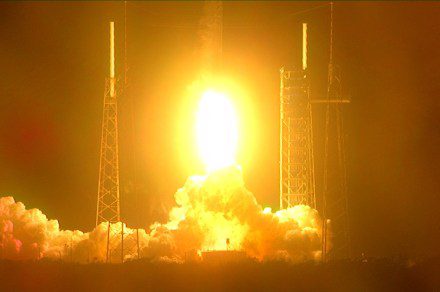NASA has launched its newest Earth-monitoring mission, a satellite tv for pc that research the ambiance and the oceans and their relationship to local weather change. The Plankton, Aerosol, Local weather, ocean Ecosystem (PACE) mission launched at 1:33 a.m. ET on Thursday, February 8, from House Launch Advanced 40 at Cape Canaveral House Drive Station in Florida.
NASA’s Plankton, Aerosol, Local weather, ocean Ecosystem (PACE) satellite tv for pc launched aboard a SpaceX Falcon 9 rocket at 1:33 a.m. ET, February 8, 2024, from House Launch Advanced 40 at Cape Canaveral House Drive Station in Florida. NASA
“Congratulations to the PACE crew on a profitable launch. With this new addition to NASA’s fleet of Earth-observing satellites, PACE will assist us be taught, like by no means earlier than, how particles in our ambiance and our oceans can determine key elements impacting world warming,” stated NASA Administrator Invoice Nelson in an announcement. “Missions like this are supporting the Biden-Harris Administration’s local weather agenda and serving to us reply pressing questions on our altering local weather.”
The mission has had a rocky historical past, because it was slated for cancellation by the Trump administration. However the mission was supported by teams just like the American Geophysical Union, which argued that learning the Earth’s local weather and climate was each scientifically necessary and fiscally accountable.
“Observations and scientific analysis from PACE will profoundly advance our information of the ocean’s position within the local weather cycle,” stated Karen St. Germain, director of NASA’s Earth Science Division. “The worth of PACE information skyrockets after we mix it with information and science from our Floor Water and Ocean Topography mission – ushering in a brand new period of ocean science. As an open-source science mission with early adopters prepared to make use of its analysis and information, PACE will speed up our understanding of the Earth system and assist NASA ship actionable science, information, and sensible functions to assist our coastal communities and industries handle quickly evolving challenges.”
NASA and SpaceX technicians safely encapsulate NASA’s PACE (Plankton, Aerosol, Cloud, ocean Ecosystem) spacecraft in SpaceX’s Falcon 9 payload fairings on Tuesday, January 30, 2024, on the Astrotech House Operations Facility close to the company’s Kennedy House Heart in Florida. NASA Goddard/Denny Henry
The spacecraft’s main instrument is the Ocean Shade Instrument (OCI), which takes information from the oceans throughout the ultraviolet, seen gentle, and near-infrared wavelengths to take a look at the presence of phytoplankton, or microscopic organisms that reside within the near-surface areas of oceans and different our bodies of water. A key a part of the marine ecosystem, these organisms take away carbon dioxide from the ambiance and supply a meals supply for a lot of ocean creatures. The spacecraft additionally has two polarimeter devices for learning how daylight adjustments when it passes by way of the ambiance.
The satellite tv for pc will now undergo a two-month commissioning interval earlier than starting its scientific observations.
Editors’ Suggestions









